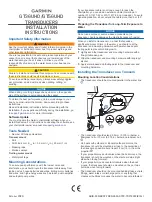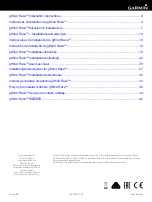
–
–
–
–
18
19
Permissions Mask
The TT Series Transceiver has a Permissions Mask that is used to
control which lines an IU is authorized to control. With most systems, if
a transmitter is associated with a receiver then it has full control over the
receiver. With the Permissions Mask, a transmitter can be granted authority
to control only certain receiver outputs. If an IU does not have the authority
to activate a certain line, then the RU does not set it.
As an example, a factory worker can be given a fob that only opens the
door to the factory floor while the CEO has a fob that can also open
the executive offices. The hardware in the fobs is the same, but the
permissions masks are set differently for each fob.
The Pair process always sets the Permission Mask to full access. The mask
can be changed through the serial interface.
Acknowledgement
A responding module is able to send an acknowledgement to the
transmitting module. This allows the initiating module to know that the
responding side received the command.
When the Responding Unit (RU) receives a valid Control Packet, it
checks the state of the ACK_EN line. If it is high the module sends an
Acknowledgement Packet.
If the Initiating Unit (IU) receives an Acknowledgement Packet that has
the same Address and Status Byte as in the Control Packet it originally
sent, then it pulls the ACK_OUT line high. A continuous stream of Control
Packets that triggers a continuous stream of Acknowledgement Packets
keeps the ACK_OUT line high.
Connecting the ACK_EN line to V
CC
causes the RU to transmit
Acknowledgement Packets as soon as it receives a valid Control Packet.
Alternately this line can be controlled by an external circuit that raises the
line when a specific action has taken place. This confirms to the IU that the
action took place and not just acknowledges receipt of the signal.
The Pair Process
The Pair process enables two transceivers to communicate with each
other. Each transceiver has a local 32-bit address that is transmitted with
every packet. If the address in the received packet is not in the RU’s Paired
Module List, then the transceiver does not respond. Adding devices to
the authorized list is accomplished through the Pair process or by a serial
command. Each module can be paired with up to 40 other modules.
The Pair process is initiated by taking the PAIR line high on both units to
be associated. Activation can either be a momentary pulse (less than
two seconds) or a sustained high input, which can be used to extend the
search and successful pairing display. With a momentary activation, the
search is terminated after 30 seconds. If Pairing is started with a sustained
high input, the search continues as long as the PAIR input is high.
When Pair is activated, the module displays the Pair Search sequence
on the MODE_IND line (Figure 17) and goes into a search mode where it
looks for another module that is also in search mode. It alternates between
transmit and receive, enabling one unit to find the other and respond.
Once bidirectional communication is established, the two units store each
other’s addresses in their Paired Module List with full Permissions Mask
and display the Pair Found sequence on their MODE_IND lines. The Pair
Found sequence is displayed for at least 3 seconds. If the PAIR input is
held high from the beginning of Pairing, the Pair Found display is shown for
as long as PAIR is high.
When Pairing is initiated, the module pairs with the first unit it finds that is
also in Pair Search. If multiple systems are being Paired in the same area,
such as in a production environment, then steps should be taken to ensure
that the correct units are paired with each other.
The Pair process can be cancelled by taking PAIR high a second time.
If the address table is full when the PAIR line is raised, the Pair Error
sequence is displayed on the MODE_IND line for 10 seconds and neither
of the Pairing units will store an address. In this case, the module should
either be reset to clear the address table or the serial interface can be used
to remove addresses.
If a paired unit is already in the Paired Module List, then no additional entry
is added though the existing entry’s Permissions Mask may be modified.
Содержание MDEV-900-TT
Страница 1: ...TT Series Remote Control Transceiver Data Guide...
Страница 7: ...8 9...













































